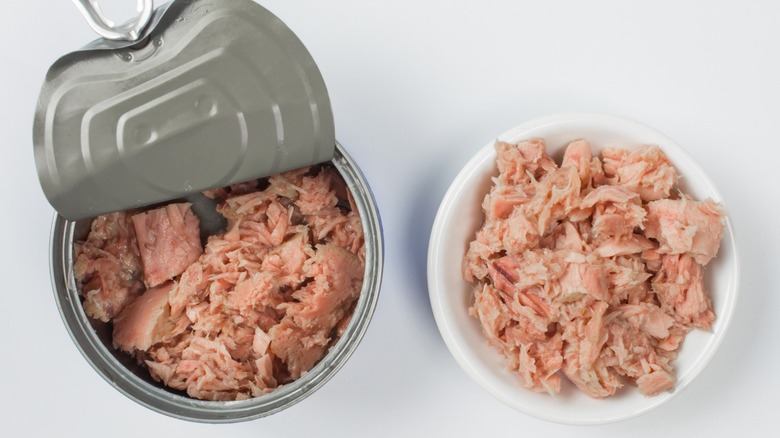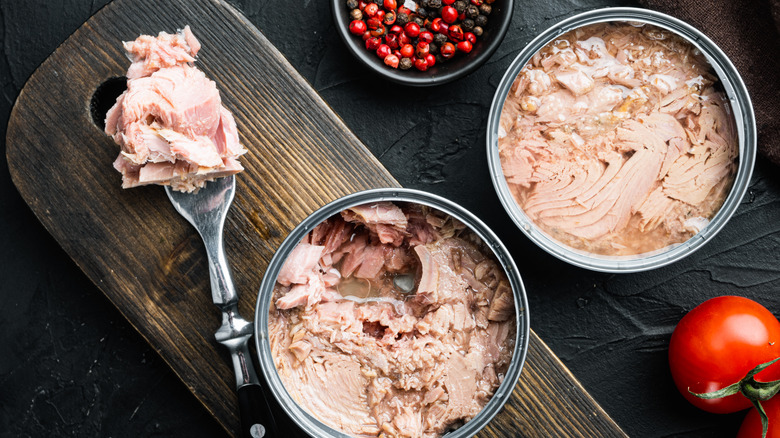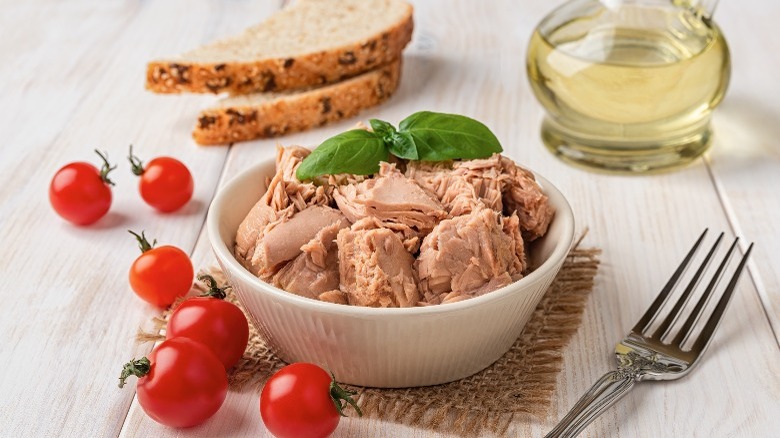Canned Tuna In Water Vs Oil: Is There Really A Nutritional Difference?
It's hard to believe that there was a time in American history where nobody ate canned tuna. Andrew Smith, author of "American Tuna: The Rise and Fall of an Improbable Fish," told The Washington Post, "It was considered a trash fish ... there wasn't any canned tuna at all in America until about 1904, and even then there wasn't much." Nowadays, tuna is everywhere — fresh, frozen, canned, packed in pouches, and in glass jars.
Canned tuna comes in albacore, skipjack, and yellowfin varieties, and is often seasoned with things like lemon pepper, garlic pepper, sun-dried tomato, Thai chilies, or jalapeños. And while most folks still crack open a can to make the traditional lunchtime staples (the tuna sandwich and the tuna salad) canned tuna's versatility and affordability can't be beaten.
Canned tuna has a number of recipe possibilities
Pair canned tuna with pasta and fresh spring peas for a light but filling supper, or mix it with breadcrumbs for some crunchy croquettes. You can wrap tuna in butter lettuce for a fresh twist on the basic tuna sandwich. Try your hand at an elevated summer salad of tuna confit over tomato salad, subbing canned tuna in oil for fresh.
Armed with a can of tuna, the possibilities are endless. Whether you enjoy albacore or skipjack, tuna salad or tuna mac, there may still be one question left looming. Which is better: tuna in oil or tuna in water?
Tuna in oil vs. tuna in water
According to the USDA, one 6.5-ounce can of drained tuna packed in oil has 317 calories while tuna packed in water yields 150 calories per can. When it comes to heart-healthy omega-3 fatty acids, tuna comes highly recommended by the American Heart Association. But whether it's packed in water or oil makes some difference, as does whether you intend to drain your canned tuna or not.
If you plan on draining your can of tuna before using it, you may want to choose tuna packed in water. That's because when you drain tuna packed in water, the omega-3s contained in this oily fish are largely retained. But when you drain tuna packed in oil, it takes some of those lovely omega-3 fats with it. In fact, a 2011 study in Public Health Nutrition shows that tuna packed in water had more omega-3 fats than tuna in oil. The study also noted, though, that oil-packaged products may be better for those with increased need for essential fatty acids (EFAs), including linoleic acid and α-linolenic acid. This includes those with conditions such as cystic fibrosis.
For those looking to boost their vitamin D or selenium, oil-packed tuna may be just the thing. Tuna packed in oil shows increased levels per serving over tuna packed in water (per U.S. Department of Agriculture).
The healthiest type of canned tuna
All tuna is good tuna — in moderation. As for mercury levels, there is no significant difference between tuna in oil versus tuna in water (via Environmental Research). The most important factor there appears to be the type, with white (or albacore) tuna showing significantly more total mercury than light (or skipjack) versions of tuna.
While there are definite differences between tuna in oil and tuna in water, choosing the best one depends on what matters most to you and how you will be using that can of tuna. If you're counting calories and maximizing omega-3 fatty acids, then tuna in water might make a great choice. On the other hand, if moisture, flavor, and vitamin D levels are your focus, then olive oil-packed tuna might be better.
Whatever tuna you choose, it's important not to go overboard for this mild-flavored fish. Because of its high sodium content and potentially elevated mercury levels, keep your tuna intake under the maximum. That should be no more than one to three 4-ounce servings (per week), depending on the type of tuna you enjoy.



